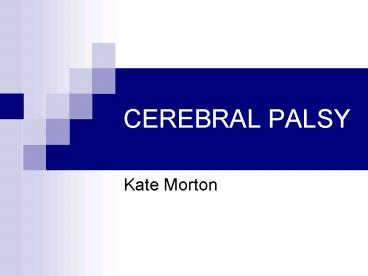CEREBRAL PALSY - PowerPoint PPT Presentation
1 / 6
Title:
CEREBRAL PALSY
Description:
CEREBRAL PALSY Kate Morton CEREBRAL PALSY Disorder of movement and posture Most common cause of motor impairment in children Due to a non-progressive lesion of the ... – PowerPoint PPT presentation
Number of Views:201
Avg rating:3.0/5.0
Title: CEREBRAL PALSY
1
CEREBRAL PALSY
- Kate Morton
2
CEREBRAL PALSY
- Disorder of movement and posture
- Most common cause of motor impairment in children
- Due to a non-progressive lesion of the motor
pathways in the developing brain - Clinical manifestations can change as the
cerebrum matures - Most common cause of motor impairment in children
- Associated conditions
- Learning impairment (60)
- Visual impairment (20)
- Squints (30)
- Hearing loss (20)
- Speech and language disorders
- Behaviour disorders
- Epilepsy (40)
3
CAUSES OF CP
- ANTENATAL (80)
- Cerebral dysgenesis
- Cerebral malformation
- Congenital infection
- INTRAPARTUM (10)
- Birth asphyxia/trauma
- POSTNATAL (10)
- Intraventricular haemorrhage/ ischaemia
- Meningitis/ encephalitis/ encephalopathy
- Head trauma/ NAI
- Symptomatic hypoglycaemia
- Hydrocephalus
- Hyperbilirubinaemia
4
PRESENTATION
- Abnormal tone and posturing
- Feeding difficulties
- Delayed motor milestones
- Abnormal gait once walking
- Developmental delay language/ social skills
- Other signs
- Hand preference under 12m
- Persistence of primitive reflexes (should
disappear by 12m)
5
CLINICAL TYPES
- Spastic (70) - damage to UMN pathway
- Increased limb tone
- Brisk tendon reflexes, extensor plantar response
- Different distributions possible hemiplegia,
diplegia, quadriplegia - Ataxic hypotonic (10) usually genetic cause
- Usually symmetrical
- Early hypotonia, poor balance, delayed motor
development - Followed by incoordinate movements, intention
tremor - Dyskinetic (10) damage to basal ganglia or
extrapyramidal pathway - Constant involuntary movements
- Poor postural control
- Floppiness and delayed motor development
- Intellect relatively intact
6
MANAGEMENT
- Importance of child health surveillance
- MDT approach
- Give parents as much information as possible
- Medical treatments for muscle spasm baclofen,
dantrolene, diazepam - Surgical scoliosis, hip reduction, tendon
lengthening, osteotomy - Others mobility aids botulinus toxin heat,
cold and vibration for spasticity splinting - Management of associated conditions eg epilepsy,
learning disability, dental problems, aspiration
pneumonia































